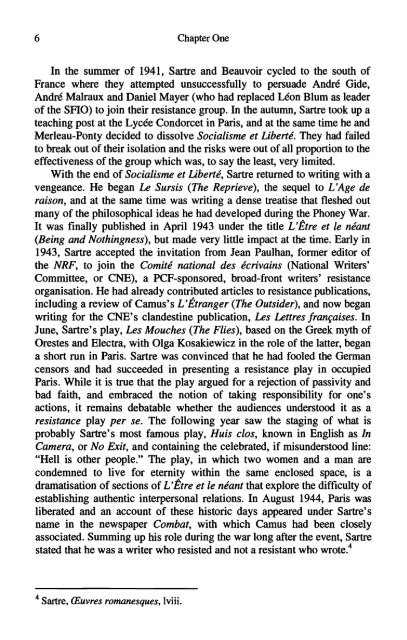Sartre's second century
Sartre's second century
Sartre's second century
You also want an ePaper? Increase the reach of your titles
YUMPU automatically turns print PDFs into web optimized ePapers that Google loves.
6<br />
Chapter One<br />
In the summer of 1941, Sartre and Beauvoir cycled to the south of<br />
France where they attempted unsuccessfully to persuade Andre Gide,<br />
Andre Malraux and Daniel Mayer (who had replaced Leon Blum as leader<br />
of the SFIO) to join their resistance group. In the autumn, Sartre took up a<br />
teaching post at the Lycee Condorcet in Paris, and at the same time he and<br />
Merleau-Ponty decided to dissolve Socialisme et Liberte. They had failed<br />
to break out of their isolation and the risks were out of all proportion to the<br />
effectiveness of the group which was, to say the least, very limited.<br />
With the end of Socialisme et Liberte, Sartre returned to writing with a<br />
vengeance. He began he Sursis (The Reprieve), the sequel to L'Age de<br />
raison, and at the same time was writing a dense treatise that fleshed out<br />
many of the philosophical ideas he had developed during the Phoney War.<br />
It was finally published in April 1943 under the title L'hre et le neant<br />
(Being and Nothingness), but made very little impact at the time. Early in<br />
1943, Sartre accepted the invitation from Jean Paulhan, former editor of<br />
the NRF, to join the Comite national des ecrivains (National Writers'<br />
Committee, or CNE), a PCF-sponsored, broad-front writers' resistance<br />
organisation. He had already contributed articles to resistance publications,<br />
including a review of Camus's Vttranger (The Outsider), and now began<br />
writing for the CNE's clandestine publication, Les Lettres frangaises. In<br />
June, <strong>Sartre's</strong> play, Les Mouches (The Flies), based on the Greek myth of<br />
Orestes and Electra, with Olga Kosakiewicz in the role of the latter, began<br />
a short run in Paris. Sartre was convinced that he had fooled the German<br />
censors and had succeeded in presenting a resistance play in occupied<br />
Paris. While it is true that the play argued for a rejection of passivity and<br />
bad faith, and embraced the notion of taking responsibility for one's<br />
actions, it remains debatable whether the audiences understood it as a<br />
resistance play per se. The following year saw the staging of what is<br />
probably <strong>Sartre's</strong> most famous play, Huis clos, known in English as In<br />
Camera, or No Exit, and containing the celebrated, if misunderstood line:<br />
"Hell is other people." The play, in which two women and a man are<br />
condemned to live for eternity within the same enclosed space, is a<br />
dramatisation of sections ofL'&re et le neant that explore the difficulty of<br />
establishing authentic interpersonal relations. In August 1944, Paris was<br />
liberated and an account of these historic days appeared under <strong>Sartre's</strong><br />
name in the newspaper Combat, with which Camus had been closely<br />
associated. Summing up his role during the war long after the event, Sartre<br />
stated that he was a writer who resisted and not a resistant who wrote. 4<br />
Sartre, (Euvres romanesques, lviii.
















